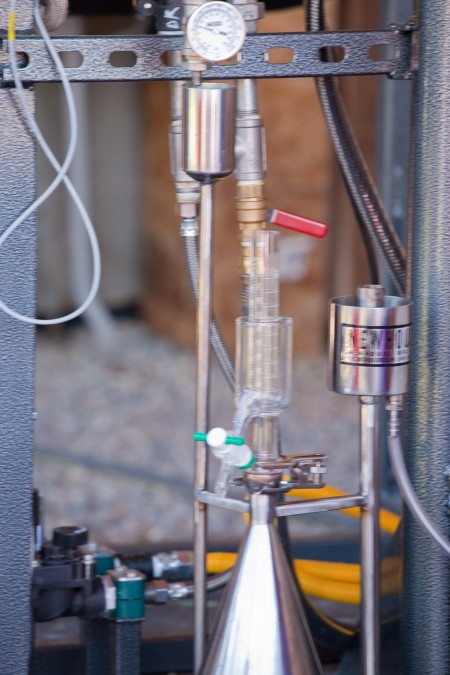Do you ever wonder how a bushy, flowering plant becomes a tiny bottle of oil?
The distillation process is nothing short of an art form, uniting the farmer, the fancy machinery, patience and care. Many months and muscles later, the lavender buds are transformed into a super-concentrated liquid aroma: essential oil.
The lavender plant is a marvel in itself, awarding us aromatic and aesthetic benefits in ever tiny flower. Now, imagine reaping the benefits of hundreds of lavender buds in one single drop of liquid.
This is distillation, and it all begins with a sickle.
The jagged teeth of this curved blade – the sickle – make harvesting lavender by hand a swift and fluid process. Harvesters slice the lavender stems a few inches below the buds with a quick pull of the hand. Swish by swish, bush by bush, row by row: It’s a dance, rhythmic, focused, in motion.
Of course, the size and style of distillation equipment varies to meet the distinct needs of personal and commercial distillers. Our own distillation unit is 98 inches tall, nearly 25 square feet and holds 35 gallons of lavender buds in the stainless steel barrel called the still. You can find a distiller that will fit in your kitchen sink.
 However big or shiny the distillation unit, the process is this: The lavender buds and stems, fresh or dried, are densely packed into the still. Water is heated either below the still or in a separate unit – the condenser – creating steam. The steam is pushed through the lavender, pulling the volatile (a fancy word for describing something that can evaporate) oils out of the plant.
However big or shiny the distillation unit, the process is this: The lavender buds and stems, fresh or dried, are densely packed into the still. Water is heated either below the still or in a separate unit – the condenser – creating steam. The steam is pushed through the lavender, pulling the volatile (a fancy word for describing something that can evaporate) oils out of the plant.
Steam carries these concentrated essences through a tube from the distillation chamber to the condensing chamber, where cold water surrounds the tube. This heat surrounded by cold causes the condensing to occur, transforming the steam-and-vaporized-oil mixture into a water-and-essential-oil mixture. Same compounds, different state: vapor to liquid.
Once the water-and-essential-oil collects in a glass or stainless steel container, it naturally begins to separate: The essential oil floats to the top, and the fragrant water, or hydrosol, sinks to the bottom. Hydrosol, a byproduct of distillation, actually packs a healthy little punch itself. Though less concentrated than pure essential oil, hydrosols contains the same plant essences that essential oils do – in a milder form.
 A special double-layered glass beaker uses overflow to collect the essential oil that has separated from the hydrosol into an outer collection vessel; however this is just one method of many that help collect the naturally separated products, essential oil and hydrosol.
A special double-layered glass beaker uses overflow to collect the essential oil that has separated from the hydrosol into an outer collection vessel; however this is just one method of many that help collect the naturally separated products, essential oil and hydrosol.
So there’s the science – Now what about the art?
Essential oil distillation is literally a transformative endeavor. To take a flower and turn it into a super-concentrated liquid is certainly astonishing. But to attribute the process to fancy technology would be overlooking the essence of essential oil distillation itself: strengthening our connection to the natural world.
Essential oils are potent gifts from nature. Organic lavender oil is naturally antiseptic, antibiotic, antidepressant, sedative and detoxifying. It promotes healing, prevents scarring, stimulates the immune system and regenerates cells of the body for healing, among other functions.
The art of essential oil distillation is no less than the art of using modern machinery to get back to the earth, sustainably, organically, and with utmost care.


Marlee Slaughter
So informative! Thank you!